In recent developments, Guyana, a small Caribbean nation bordered by Venezuela and Suriname, experienced significant changes regarding the tariffs imposed by the United States under President Donald Trump. Initially facing an astonishing 38% tariff on numerous exports, Guyana has now been granted a 90-day reprieve. During this pause, the tariff has been reduced to a manageable 10%, aligning the country’s trade status more closely with that of its regional counterparts, save for Canada, China, and Mexico.
The backdrop of this tariff adjustment is not merely an administrative change; it highlights a broader geopolitical struggle, particularly the tension between the United States and China. Francis Bailey, a prominent political commentator in Guyana, articulates that Guyana is caught in this friction, as Washington has expressed concerns over China’s increasing influence in the region. Specifically, Chinese investments, which total billions and span various sectors from infrastructural development to healthcare and retail, have made a considerable mark on Guyana’s economic landscape. For instance, a notable project currently in development is a bridge linking Georgetown, the capital, to areas in the western Demerara-Mahaica region. This construction is being undertaken by a firm based in Beijing.
Historically, the U.S. has maintained beneficial trade relations with Guyana, procuring critical natural resources such as crude oil, gold, and bauxite, the latter being vital for aluminum production. The exports that comprise these resources were to be exempt from the hefty 38% tariff. However, industries pivotal to the local economy, such as fishing and sugar, were set to bear the brunt of these tariffs. During a visit in March, U.S. Secretary of State Marco Rubio reinforced American support for Guyana, particularly regarding its ongoing territorial dispute with Venezuela over the Essequibo region. This involvement indicates that the U.S. has a vested interest in stabilizing Guyana and limiting Chinese incursions, as underscored by Bailey, who describes the tariff situation as a strategic move to compel Guyana to distance itself from China.
Notably, the Guyanese government has remained relatively silent in public discussions surrounding these tariff issues. Nonetheless, the country’s economic prospects have seen a remarkable turnaround following the discovery of oil within its waters in 2015. Recent estimates cite that Guyana exported over $3 billion worth of crude oil to the U.S. last year. The more widespread concern among Caribbean nations focuses on the broader impact that these tariffs may have on imports from the U.S. Given that many Caribbean islands rely heavily on American goods for up to 70% of their consumption, any increases in costs due to tariffs will likely translate directly to higher prices for local consumers.
Furthermore, the precarious balance of trade is compounded by the rising shipping costs and local duties inherent to Caribbean markets, where many essential products are often acquired through American supply chains. The U.S. has recently imposed tariffs up to 125% on Chinese goods, which could also result in increased pricing for items re-exported through the U.S. to the Caribbean.
As a case in point, in Antigua and Barbuda, residents express growing anxiety about potential price hikes, with local business leaders focusing on how to mitigate the economic impact. Carissa Warner, an interior designer from Antigua, reported that 70% of her materials come from the U.S., indicating the high stakes involved in this trade dynamic. Both she and Antigua’s Prime Minister Gaston Browne advocate for a pivot towards local sourcing to alleviate financial pressures stemming from rising import costs.
In conclusion, the shifting tariff landscape underscores Guyana’s delicate positioning within a broader geopolitical framework, where external influences—primarily from the U.S. and China—intersect with domestic economic interests. As Caribbean nations look to navigate this context, leaders emphasize the importance of diversifying their trade partnerships while reinforcing local production capabilities to bolster resilience against future economic disruptions.



